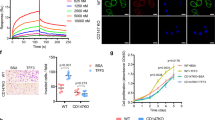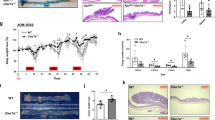Abstract
Mice overexpressing progastrin (PG) in intestinal mucosa (fatty acid-binding protein (Fabp)-PG mice) are at an increased risk of proximal colon carcinogenesis in response to azoxymethane. Here, we report a significant increase in the length of proximal colonic crypts in Fabp-PG mice, associated with potent antiapoptotic effects of PG, which likely contributed to the previously reported increase in colon carcinogenesis in Fabp-PG mice. Phosphorylation of kinase of IκBα (IKKα/β), inhibitor of κB (IκB)α and p65NF-κB was significantly elevated in proximal colonic crypts of Fabp-PG versus wild-type mice, which was associated with degradation of IκBα and nuclear translocation/activation of p65. Surprisingly, distal colonic crypt cells were not as responsive to elevated levels of PG in Fabp-PG mice. Annexin II, recently described as a high-affinity receptor for PG, strongly co-localized with PG intracellularly and on basolateral membranes of proximal crypt cells, providing evidence that annexin-II binds PG in situ in colonic crypt cells. Proliferative and antiapoptotic effects of PG on proximal crypts of Fabp-PG mice were attenuated to wild-type levels, on treatment with NEMO peptide (an inhibitor of nuclear factor-κB (NF-κB) activation), demonstrating for the first time a critical role of NF-κB in mediating hyperproliferative affects of PG on colonic crypts of Fabp-PG mice, in vivo. Thus, downregulation of NF-κB may significantly reduce the increased risk of colon carcinogenesis in response to PG.
This is a preview of subscription content, access via your institution
Access options
Subscribe to this journal
Receive 50 print issues and online access
$259.00 per year
only $5.18 per issue
Buy this article
- Purchase on Springer Link
- Instant access to full article PDF
Prices may be subject to local taxes which are calculated during checkout






Similar content being viewed by others
Abbreviations
- ANX-II:
-
annexin-II
- IκB:
-
inhibitor of κB
- IKK:
-
IκB kinase
- NF-κB:
-
nuclear factor-κB
- PG:
-
progastrin
- PI:
-
proliferation index
- WT:
-
wild-type littermates
- Tg:
-
transgenic
- WB:
-
western blot
References
Ahmed S, Murphy RF, Lovas S . (2005). Importance of N- and C-terminal regions of gastrin-Gly for preferential binding to high and low affinity gastrin-Gly receptors. Peptides 26: 1207–1212.
Aly A, Shulkes A, Baldwin GS . (2001). Short term infusion of glycine-extended gastrin(17) stimulates both proliferation and formation of aberrant crypt foci in rat colonic mucosa. Int J Cancer 94: 307–313.
Baldwin GS, Hollande F, Yang Z, Karelina Y, Paterson A, Strang R et al. (2001). Biologically active recombinant human progastrin(6-80) contains a tightly bound calcium ion. J Biol Chem 276: 7791–7796.
Chicone L, Narayan S, Townsend Jr CM, Singh P . (1989). The presence of a 33–40 KDa gastrin binding protein on human and mouse colon cancer. Biochem Biophys Res Commun 164: 512–519.
Chung CY, Erickson HP . (1994). Cell surface annexin II is a high affinity receptor for the alternatively spliced segment of tenascin-C. J Cell Biol 126: 539–548.
Cobb S, Wood T, Ceci J, Varro A, Velasco M, Singh P . (2004). Intestinal expression of prograstin significantly increases colon carcinogenesis in transgenic mice in response to AOM. Cancer 100: 1311–1323.
Dasgupta S, Jana M, Zhou Y, Fung YK, Ghosh S, Pahan K . (2004). Antineuroinflammatory effect of NF-kappaB essential modifier-binding domain peptides in the adoptive transfer model of experimental allergic encephalomyelitis. J Immunol 173: 1344–1354.
Dockray GJ, Varro A, Dimaline R . (1996). Gastric endocrine cells: gene expression, processing, and targeting of active products. Physiol Rev 76: 767–798.
Ferrand A, Bertrand C, Portolan G, Cui G, Carlson J, Pradayrol L . (2005). Signaling pathways associated with colonic mucosa hyperproliferation in mice overexpressing gastrin precursors. Cancer Res 65: 2770–2777.
Fric P, Sovova V, Sloncova E, Lojda Z, Jirasek A, Cermak J . (2000). Different expression of some molecular markers in sporadic cancer of the left and right colon. Eur J Cancer Prev 9: 265–268.
Glebov OK, Rodriguez LM, Nakahara K, Jenkins J, Cliatt J, Humbyrd CJ . (2003). Distinguishing right from left colon by the pattern of gene expression. Cancer Epidemiol Biomarkers Prev 12: 755–762.
Hajjar KA, Jacovina AT, Chacko J . (1994). An endothelial cell receptor for plasminogen/tissue plasminogen activator. I. Identity with annexin II. J Biol chem 269: 21191–21197.
Hayden MS, Ghosh S . (2004). Signaling to NF-kappa B. Genes Dev 18: 2195–2224.
Hong MY, Chapkin RS, Wild CP, Morris JS, Wang N, Carroll RJ et al. (1999). Relationship between DNA adduct levels, repair enzyme, and apoptosis as a function of DNA methylation by azoxymethane. Cell Growth Differ 10: 749–758.
Iacopetta B . (2002). Are there two sides to colorectal cancer? Int J Cancer 101: 403–408.
Johnson LR, McCormack SA . (1994). Physiology of the Gastrointestinal Tract, 3rd edn. Raven Press: New York.
Lifshitz S, Lamprecht SA, Benharroch D, Prinsloo I, Polak-Charcon S, Schwartz B . (2001). Apoptosis (programmed cell death) in colonic cells: from normal to transformed stage. Cancer Lett 163: 229–238.
Liu LU, Holt PR, Krivosheyev V, Moss SF . (1999). Human right and left colon differ in epithelial cell apoptosis and in expression of Bak, a pro-apoptotic Bcl-2 homologue. Gut 45: 45–50.
Marshman E, Ottewell PD, Potten CS, Watson AJ . (2001). Caspase activation during spontaneous and radiation-induced apoptosis in the murine intestine. J Pathol 195: 285–292.
May MJ, D'Acquisto F, Madge LA, Glöckner J, Pober JS, Ghosh S . (2000). Selective inhibition of NF-kappaB activation by a peptide that blocks the interaction of NEMO with the IkappaB kinase complex. Science 289: 1550–1554.
Mills SJ, Mathers JC, Chapman PD, Burn J, Gunn A . (2001). Colonic crypt cell proliferation state assessed by whole crypt microdissection in sporadic neoplasia and familial adenomatous polyposis. Gut 48: 41–46.
Müerköster S, Isberner A, Arlt A, Witt M, Reimann B, Blaszczuk E et al. (2005). Gastrin suppresses growth of CCK2 receptor expressing colon cancer cells by inducing apoptosis in vitro and in vivo. Gastroenterology 129: 952–968.
Ortiz-Zapater E, Peiró S, Roda O, Corominas JM, Aguilar S, Ampurdanés C et al. (2007). Tissue plasminogen activator induces pancreatic cancer cell proliferation by a non-catalytic mechanism that requires extracellular signal-regulated kinase 1/2 activation through epidermal growth factor receptor and annexin A2. Am J Pathol 170: 1573–1584.
Ottewell PD, Varro A, Dockray GJ, Kirton CM, Watson AJ, Wang TC et al. (2005). COOH-terminal 26-amino acid residues of progastrin are sufficient for stimulation of mitosis in murine colonic epithelium in vivo. Am J Phsyiol Gastrointest Liver Physiol 288: G541–G549.
Ottewell PD, Watson AJ, Wang TC, Varro A, Dockray GJ, Pritchard DM . (2003). Progastrin stimulates murine colonic epithelial mitosis after DNA damage. Gastroenterology 124: 1348–1357.
Rengifo-Cam W, Singh P . (2004). Role of progastrins and gastrins and their receptors in GI and pancreatic cancers: targets for treatment. Curr Pharm Des 10: 2345–2358.
Rengifo-Cam W, Umar S, Sarkar S, Singh P . (2007). Anti-apoptotic effects of progastrin on pancreatic cancer cells are mediated by sustained activation of nuclear factor κB. Cancer Res 67: 7266–7274.
Sarkar S, Umar S, Singh G, Singh P . (2007). Progastrin (PG) peptide co-localizes with annexin II (ANX-II), in situ, in human colon cancer cells (HCT-116), expressing autocrine PG, and in intestinal epithelial cells (IEC-18) in response to PG stimulation. Gastroenterology 132: A540–A541.
Sato M, Ahnen DJ . (1992). Regional variability of colonocyte growth and differentiation in the rat. Anat Rec 233: 409–414.
Seva C, Dickinson CJ, Yamada T . (1994). Growth-promoting effects of glycine-extended progastrin. Science 265: 410–412.
Singh P . (2007). Role of annexin-II in GI cancers: interaction with gastrins/progastrins. Cancer Lett 252: 19–35.
Singh P, Lu X, Cobb S, Miller BT, Tarasova N, Varro A et al. (2003). Progastrin1-80 stimulates growth of intestinal epithelial cells in vitro via high-affinity binding sites. Am J Physiol Gastrointest Liver Physiol 284: G328–G339.
Singh P, Velasco M, Given R, Varro A, Wang TC . (2000A). Progastrin expression predisposes mice to colon carcinomas and adenomas in response to a chemical carcinogen. Gastroenterology 119: 162–171.
Singh P, Velasco M, Given R, Wargovich M, Varro A, Wang TC . (2000B). Mice overexpressing progastrin are predisposed for developing aberrant colonic crypt foci in response to AOM. Am J Physiol Gastrointest Liver Physiol 278: G390–G399.
Singh P, Wu H, Clark C, Owlia A . (2007). Annexin II binds progastrin and gastrin-like peptides, and mediates growth factor effects of autocrine and exogenous gastrins on colon cancer and intestinal epithelial cells. Oncogene 26: 425–440.
Song DH, Rana B, Wolfe JR, Crimmins G, Choi C, Albanese C . (2003). Gastrin-induced gastric adenocarcinoma growth is mediated through cyclin D1. Am J Physiol Gastrointest Liver Physiol 285: G217–G222.
Umar S, Morris AP, Kourouma F, Sellin JH . (2003). Dietary pectin and calcium inhibit colonic proliferation in vivo by differing mechanisms. Cell Prolif 36: 361–375.
Umar S, Sellin JH, Morris AP . (2000). Increased nuclear translocation of catalytically active PKC-zeta during mouse colonocyte hyperproliferation. Am J Physiol Gastrointest Liver Physiol 279: G223–G237.
Umar S, Wang Y, Morris AP, Sellin JH . (2007). Dual alterations in casein kinase I-epsilon and GSK-3beta modulate beta-catenin stability in hyperproliferating colonic epithelia. Am J Physiol Gastrointest Liver Physiol 292: G599–G5607.
Wang TC, Koh TJ, Varro A, Cahill RJ, Dangler CA, Fox JG et al. (1996). Processing and proliferative effects of human progastrin in transgenic mice. J Clin Invest 98: 1918–1929.
Wang Y, Xiang GS, Kourouma F, Umar S . (2006). Citrobacter rodentium-induced NF-kappa B activation in hyperproliferating colonic epithelia: role of p65 (Ser(536)) phosphorylation. Br J Pharmacol 148: 814–824.
Watanabe T, Kobunai T, Toda E, Yamamoto Y, Kanazawa T, Kazama Y . (2006). Distal colorectal cancers with microsatellite instability (MSI) display distinct gene expression profiles that are different from proximal MSI cancers. Cancer Res 66: 9804–9808.
Wu H, Owlia A, Singh P . (2003). Precursor peptide progastrin(1-80) reduces apoptosis of intestinal epithelial cells and upregulates cytochrome c oxidase Vb levels and synthesis of ATP. Am J Physiol Gastrointest Liver Physiol 285: G1097–G1110.
Zizzo MG, Mule F, Serio R . (2006). Inhibitory responses to exogenous adenosine in murine proximal and distal colon. Br J Pharmacol 148: 956–963.
Acknowledgements
This work was supported by grant nos. CA97959 and CA114264 to P Singh, and Grant no. CA099121 to S Umar from the NIH.
Author information
Authors and Affiliations
Corresponding author
Additional information
Supplementary Information accompanies the paper on the Oncogene website (http://www.nature.com/onc)
Rights and permissions
About this article
Cite this article
Umar, S., Sarkar, S., Cowey, S. et al. Activation of NF-κB is required for mediating proliferative and antiapoptotic effects of progastrin on proximal colonic crypts of mice, in vivo. Oncogene 27, 5599–5611 (2008). https://doi.org/10.1038/onc.2008.169
Received:
Revised:
Accepted:
Published:
Issue Date:
DOI: https://doi.org/10.1038/onc.2008.169
Keywords
This article is cited by
-
A novel antibody against cancer stem cell biomarker, DCLK1-S, is potentially useful for assessing colon cancer risk after screening colonoscopy
Laboratory Investigation (2017)
-
PLCε signaling in cancer
Journal of Cancer Research and Clinical Oncology (2016)
-
Progastrin a new pro-angiogenic factor in colorectal cancer
Oncogene (2015)
-
Epigenetic changes and alternate promoter usage by human colon cancers for expressing DCLK1-isoforms: Clinical Implications
Scientific Reports (2015)
-
Intracellular annexin A2 regulates NF-κB signaling by binding to the p50 subunit: implications for gemcitabine resistance in pancreatic cancer
Cell Death & Disease (2015)



